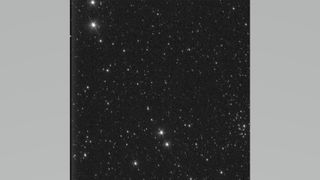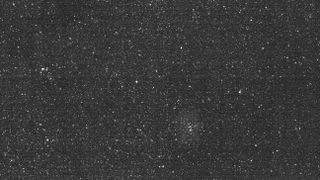Here's the view from a NASA spacecraft bound for Jupiter asteroids

The journey out to Jupiter's orbit is full of stars.
NASA's Lucy spacecraft is early in its long trek to explore a group of asteroids called the Jupiter Trojans, which are small remnants of our early solar system that share the planet Jupiter's orbit around the sun.
Lucy launched from NASA's Kennedy Space Center in Florida atop a United Launch Alliance (ULA) Atlas V rocket on Oct. 16, 2021, and is preparing for an Earth flyby this fall before it begins its asteroid explorations. During the cruise, mission personnel are also completing tasks like instrument calibration, and new images taken during a February test of the spacecraft's four visible-light cameras offer a detailed view of 11 different star fields.
Related: The greatest asteroid missions of all time!
The spacecraft's four cameras include the twin Terminal Tracking Cameras (T2CAM), the Multicolor Visible Imaging Camera (MVIC) and the Long-Range Reconnaissance Imager (L'LORRI). The calibration test, which occurred on Feb. 14, used Lucy's Instrument Pointing Platform to test the cameras' performance, sensitivity and accuracy when pointed in different directions, according to the NASA statement.
The T2CAM cameras have a wide field of view and are used to automatically lock onto and track certain targets, such as the Trojan asteroids during Lucy's close flybys. In turn, the twin cameras help ensure that the spacecraft's other instruments are pointed at the target.
One of the Feb. 14 test images was a 10-second exposure of the Rosette Nebula, which is visible in the lower right center of the frame, taken using the T2CAM.
Get the Space.com Newsletter
Breaking space news, the latest updates on rocket launches, skywatching events and more!

MVIC, which is part of the L'Ralph instrument, is a higher-resolution color scanning camera that produces panoramic views of space. During the test, a narrow part of the T2CAM field was captured and processed so that the faint stars could be seen against the dark backdrop of space.
Lucy's most sensitive camera, L'LORRI, is a high-resolution monochromatic telephoto camera with a narrow 0.29-degree-square field of view. It is the same kind of telescope as the instrument on board the Hubble Space Telescope and will capture the most detailed images of the mission's asteroid targets. The test images captured stars roughly 50,000 times fainter than the unaided human eye can see, according to the NASA statement.
The Feb. 14 test was a follow-up to the first set of test images taken in November 2021, only a few months after Lucy's launch. Therefore, this recent test was much more extensive, allowing the spacecraft's team to test its camera functionality. However, the test did not include Lucy's infrared spectrometer LEISA, which is also part of the L'Ralph instrument, or the spacecraft's temperature mapping L'TES instrument, which requires close-up planetary targets to obtain useful data.
The Lucy spacecraft is slated to arrive at its first target in 2025 — a main belt asteroid named 52246 Donaldjohanson after the paleontologist who discovered the hominin fossil Lucy that is the mission's namesake.
Follow Samantha Mathewson @Sam_Ashley13. Follow us on Twitter @Spacedotcom and on Facebook.
Join our Space Forums to keep talking space on the latest missions, night sky and more! And if you have a news tip, correction or comment, let us know at: community@space.com.

Samantha Mathewson joined Space.com as an intern in the summer of 2016. She received a B.A. in Journalism and Environmental Science at the University of New Haven, in Connecticut. Previously, her work has been published in Nature World News. When not writing or reading about science, Samantha enjoys traveling to new places and taking photos! You can follow her on Twitter @Sam_Ashley13.
